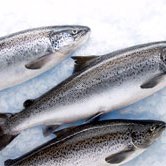The Oceanic Institute has praised Environmental Defense on its recent decision to add US-farmed shrimp to its “Best Eco-Choices” Seafood Selector card, a move that the Hawaii-based research institute says is expected to help local shrimp farmers by increasing demand.
Environmental Defence created the card to help consumers select seafood that is both ecologically friendly and healthy to eat because it is low in dangerous contaminants. It ranks seafood by environmental impact as well as by contaminant levels. US-farmed shrimp made the list for the first time this year.
Oceanic Institute, working as part of the United States Marine Shrimp Farming Program (USMSFP), a consortium of seven of the nation’s leading shrimp research institutions, helped develop the breakthrough research that gave US-based shrimp farmers the boost they needed to grow healthy shrimp in an environmentally-friendly way.
“This is exciting news for Hawaii’s shrimp farmers,” said Dr. Bruce Anderson, Oceanic Institute’s president. “This important endorsement of US-farmed shrimp from a prestigious organization like Environmental Defense will help create even more demand for high-quality shrimp,” Anderson said. “Now, consumers can have confidence that not only is US-farmed shrimp delicious and good for you, but it’s also good for the environment too,” he added.
Currently domestic farmed shrimp production represents less than 1% of the total shrimp consumed in the US, with the vast majority being imported from other countries like Thailand. The Ocean Institute hopes this designation will help the US shrimp farming industry develop the reputation for high quality and high environmental standards it deserves.
“Many US shrimp farms have adopted management practices that greatly reduce their environmental impact. The farms avoid environmental pitfalls, such as frequent wastewater discharges, that have bedeviled shrimp farming abroad," said Dr. Rebecca Goldburg, Environmental Defense. "The Oceanic Institute and the rest of the USMSFP deserve credit for helping make US shrimp farming more environmentally sound."
As a key member of the USMSFP, Oceanic Institute worked closely with both the Hawaii and mainland-based shrimp industry to help make farming methods more environmentally-friendly.
"This designation comes after 20 years of research in the US, lead by the USMSFP and the Oceanic Institute,” said Dr. Tony Ostrowski, Director of the USMSFP. “US shrimp farmers have applied researched bio-security measures, technologies and animals that are the cornerstone of an environmentally-sustainable shrimp production,” explained Ostrowski.
Water reuse technologies have reduced needs in Texas, for instance, from over 4,500 gallons for each pound of shrimp produced in 1994 to less than 250 gallons per pound produced today, with magnitude decreases in pollution indicators. And, newer technologies being researched by Ocean Institute and the USMSFP promise to reduce water usage rates to less than 8 gallons of water per pound of shrimp produced.
Further emphasis of the USMSFP on disease diagnostics, control, and preventative breeding have allowed the U.S. to be among a select group of nations to boast a virus-free shrimp farming status since 1999 and until the beginning of the 2004 season, Ostrowski explained.
A key element of bio-secure production practices is the use of specific pathogen-free (SPF) and specific-pathogen resistant (SPR) shrimp. These are shrimp bred to be free of and exhibit resistance to certain diseases that could escape into local ecosystems. Oceanic Institute, under the USMSFP, pioneered the development of SPF and SPR shrimp, and distributed stocks to US farmers and broodstock suppliers. Over 90% of the shrimp raised in the US today can trace their origins back to the Ocean Institute.
One of the many Hawaii shrimp farmers who could benefit from the new Environmental Defense assessment is Dr. Paul Bienfang, who represents a 40-acre shrimp farm on Kauai, Hawaii. “It’s important to get the word out that Hawaii’s shrimp are among the best in the world, and this program should help us do just that,” said Bienfang. “It’s exciting to know that when a consumer wants to make a healthy, smart, environmentally-correct choice when selecting shrimp, he or she will look for shrimp from Hawaii or the US, as opposed to foreign producers that may not have our high standards,” he added.
Oceanic Institute is a not-for-profit organization dedicated to research, development and transfer of oceanographic, marine environmental, and aquaculture technologies. The largest marine aquaculture research institution in the U.S., Oceanic Institute is a world leader in conducting applied research in aquaculture production and marine resource conservation.
Oceanic Institute has more than 100 scientists, professionals, and support personnel on staff at its main, 56-acre campus on Oahu at Makapuu, and at its facilities on the Big Island and Molokai. The Institute generates more than $8 million annually in government grants, private donations, and contract services that support a wide range of projects.
Resources
For more about the Oceanic Institute website
For more on the Environmental Defense “Best Eco-Choices” Seafood Selector card, visit the Oceans Alive campaign website
For more on US aquaculture production and trade, download the latest (October 2004) USDA ERS Aquaculture Outlook Report [PDF]
Send comments on this story to: editor@aquafeed.com











